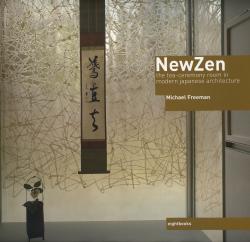New Zen: the tea-ceremony room in modern Japanese architecture

Eightbooks Ltd, 2007, 240 pages. Hardback, £35.00. ISBN 13: 978-0-9554322-0-0
Review by Suzanne Perrin
A specialist in Asian art and architecture, Michael Freeman is a London based photographer who has contributed several publications on Japanese and Oriental themes. The text, design and photographs are all done by him for this book.
There has always been a western fascination with “Zen”, whether it be austere Buddhist practices, minimal gardens of rock and sand, ferocious sword-play, or tranquil tea rituals. This latest offering to the Zen catalogue of associated topics deals with an exploration of contemporary Japanese architecture, and how the constraints of a tea room, Chashitsu, are finding expression in contemporary Japan by well established and up-coming designers.
The flyleaf states: “Since the 1990s Japanese architects and designers have been re-interpreting the Chashitsu [tea ceremony rooms] creating modern meditative spaces .. …..featuring a vast array of materials including paper, wood, plastic, stone, aluminum, glass and concrete.”
Freeman introduces the book as “a series of experiments, undertaken individually and with little in the way of publicity” for its designers and architects. He calls the tea room “a very loaded space”, due to its six hundred year tradition of infusing art, culture, philosophy, ideology and design all around the central act of making tea for a guest (or two).
The book first peruses the history of the tea ceremony, drawing on quotations from Sen no Rikyu, Kobori Enshu, Tenshin Okakura and Lafcadio Hearn, all renowned writers on the way of tea and its basic concepts. An Introduction gives an overview of the evolution of the tea ceremony serving to enlighten readers with the genre, and is illustrated with a plan view of a traditional tea room with a glossary of terms for tea ceremony procedures. Ensuing section titles cover areas devoted to New Traditional, Modern Materials, Garden Settings, and Contemporary Interpretations.
Freeman likens the appeal of the Chashitsu in modern day Japan as being “an inspiration” from older traditions of austerity and simplicity in the face of 1980s “Bubble” economy excess and indulgence. Very relevant then, in the light of current financial crises across the globe.
It is with these ideas of re-interpreting the formula of Chashitsu as an oasis of calm reflection in a frenetic world, translated by contemporary architects such as Arata Isozaki, Kengo Kuma, Kisho Kurokawa, Shigeru Uchida and many lesser known names working in the design field, that draws together the threads of tea culture, Zen ethos and cutting edge design style.
The photography throughout is beautiful, with carefully chosen images showing the details of materials, surface textures, light, pattern and space that all contribute to the harmony, respect and reverence for craftsmanship that goes with tea aesthetics. There is much to fascinate here in the many and varied ways of constructing a tea room – or space.
In the section marked “Contemporary Interpretations,” one example offers a portable tea space called Sankio (In the Mountains), by Shigeru Uchida from 2005, a light, cubic structure measuring 2.8 sq metres with a height of 2.3 m, made from an open lattice of black bamboo strips woven into a mesh for walls, with a black wooden floor vestibule and thin woven mat flooring for the main space. This flexibility allows for kakejiku (scrolls) to be hung anywhere along the lattice walls. The ro (hearth) is not sunken but placed in a wooden designed box in the corner for portability. The visuals are stunning, both inside and out.
Other innovative places for tea areas (some challenge the meaning of the word ‘room’) include a Chashitsu located within a greenhouse complex in Millennium City near Narita by Hiroshi Iguchi; the “Too High” (Takasugian) tea house perched on top of a truncated tree with views of the Nagano hills in Chino by Terunobu Fujinori; the circular steel and glass rooftop tea space with fixtures more appropriate to a bathroom than a tea room by Kunihiko Hayakawa; and an aluminium suitcase that unfolds into a portable, tent-like structure that creates possibly the smallest tea space imaginable, by Toshihiko Suzuki.
Overall some thirty-seven examples are illustrated, but despite the variety of formats and excellent photographs, not enough information is given on the materials and construction of these iconoclastic “tea spaces.” Even so, this is a ‘must have’ coffee table book for Japanese design aficionados everywhere.

